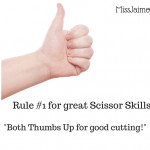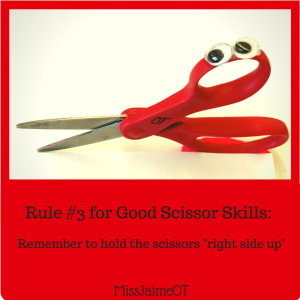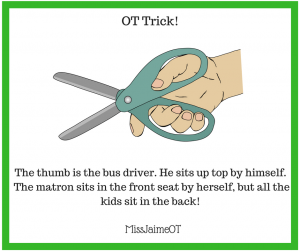
5 Tricks to help your child with cutting
1. Thumbs up for good cutting! Teach your child that “thumbs up” means “good job”. Then, show them that in order to cut properly, both hands should be “thumbs up” or “thumbs on top”. Most parents don’t realize that their child is”thumbs down” on the hand that holds the paper. In order to have the best control, both thumbs should be facing up.  2. Elbows in! Many children use their whole arm when they only need their hands. This is a sign that they are still developing shoulder stability. You’ll notice that they may stick their elbow out, instead of keeping it stable by their body. This is a sign that they are compensating for weak upper body strength and stability. You can help this along by having your child spend more time on their belly when reading or doing puzzles, etc. In the meantime when they are cutting, remind them “elbows tucked in”. This will give them better control.
2. Elbows in! Many children use their whole arm when they only need their hands. This is a sign that they are still developing shoulder stability. You’ll notice that they may stick their elbow out, instead of keeping it stable by their body. This is a sign that they are compensating for weak upper body strength and stability. You can help this along by having your child spend more time on their belly when reading or doing puzzles, etc. In the meantime when they are cutting, remind them “elbows tucked in”. This will give them better control. 
3. Right side up!
If your child consistently forgets to hold the scissors right side up with their thumb in the little hole, make it fun by drawing a face on their thumb or their thumbnail before they begin cutting. Tell them that the thumb is the bus driver. He sits in the front seat (small window) by himself. The rest of the fingers are the kids, they sit in the back together. Most kids like this trick.  If they still have trouble after a few times, you can also try gluing or drawing eyes on the “little hole”. This way, when your little one picks up the scissors, the eyes are “watching him”. Hot glue does not last very long on plastic, but that’s ok! Hopefully, by the time the googly eyes fall off, your child will have developed the proper habit.
If they still have trouble after a few times, you can also try gluing or drawing eyes on the “little hole”. This way, when your little one picks up the scissors, the eyes are “watching him”. Hot glue does not last very long on plastic, but that’s ok! Hopefully, by the time the googly eyes fall off, your child will have developed the proper habit. 
4. The writing hand is the cutting hand!
Children should have developed their hand dominance by the time they are four. However, sometimes they may still switch for certain activities. With scissors, I find that lefties often switch to “righty” to cut because the blades of typical scissors work better when cutting with the right hand. (Most lefty scissors have the blades reversed – who knew!?) Some parents buy their child lefty scissors to make it easier. I highly suggest this! But they may still switch hands. If your child is switching hands, encourage them to use their dominant hand. If you aren’t sure whether they are lefty or righty, watch which hand they use to pick up their fork, crayon, or a toy. Place objects in the middle of their body and see which hand they prefer. Once your child has chosen a hand, encourage that hand for cutting, coloring, and using a fork. One tip to help them remember is to use a tattoo! Put a removable tattoo on your child’s dominant hand as a “reminder”. Kids love tattoos and it’s an easy fix.
5. Get those muscles strong!
One of the reasons that cutting is difficult for children is that they have to separate the two sides (pinky and thumb) of their hands. This is hard work, and sometimes hard work is NOT fun. If your little guy gets frustrated with cutting, work on their hand strength with other activities that work the same muscles. This way, the muscles are getting stronger while your child is having fun doing something “different”. Here are some simple everyday activities that develop separation of the two sides of the hand: 1) Fill an empty spray bottle with water and let your children spray the plants, the car, the chalk off the driveway! 2) Bring it to the beach or the pool and let your children spray you, themselves, or each other when they get hot! 3) Same goes for old-fashioned (trigger style) water guns. 4) Use your old tweezers to pick up beans, beads, or anything small. 5) Use Spaghetti Tongs to pick up all the dirty laundry (or anything else) off the floor. 5) Use an old sock to make a sock puppet – draw a mouth and a face so your child practices “opening and shutting” the mouth as he talks.  Hope these simple tricks help you to help your child with the tough task of learning how to cut! Good Luck!
Hope these simple tricks help you to help your child with the tough task of learning how to cut! Good Luck!



GREAT JOB Miss. Jaime!!! These are wonderful suggestions for parents!
HI…
I have been helping a 6 yr old who should be starting kindergarten …but never had previous time using scissors so this is new for him. It is great to read your pages. I have been already been trying to do some of stuff you suggesting and I know we have to strengthen hands and work on dexterity. (I usually tutor high school kids! I am doing this as a gift for parents and the child…..) I do need to look at position of shoulder next time and I realize that may be part of problem…the shoulder stability. I am very aware that other parts of the arm can be contributing to this issue. I also note that he places thumb all the way through the top scissor opening so the scissors is resting at very bottom of thumb. … and he is resistant to my suggestions to change that. I will try to get him to try both ways and let him decide which is the easier way to cut. so far, the cutting has not been very good. Any suggestions/tricks for changing the thumb position, or other….?